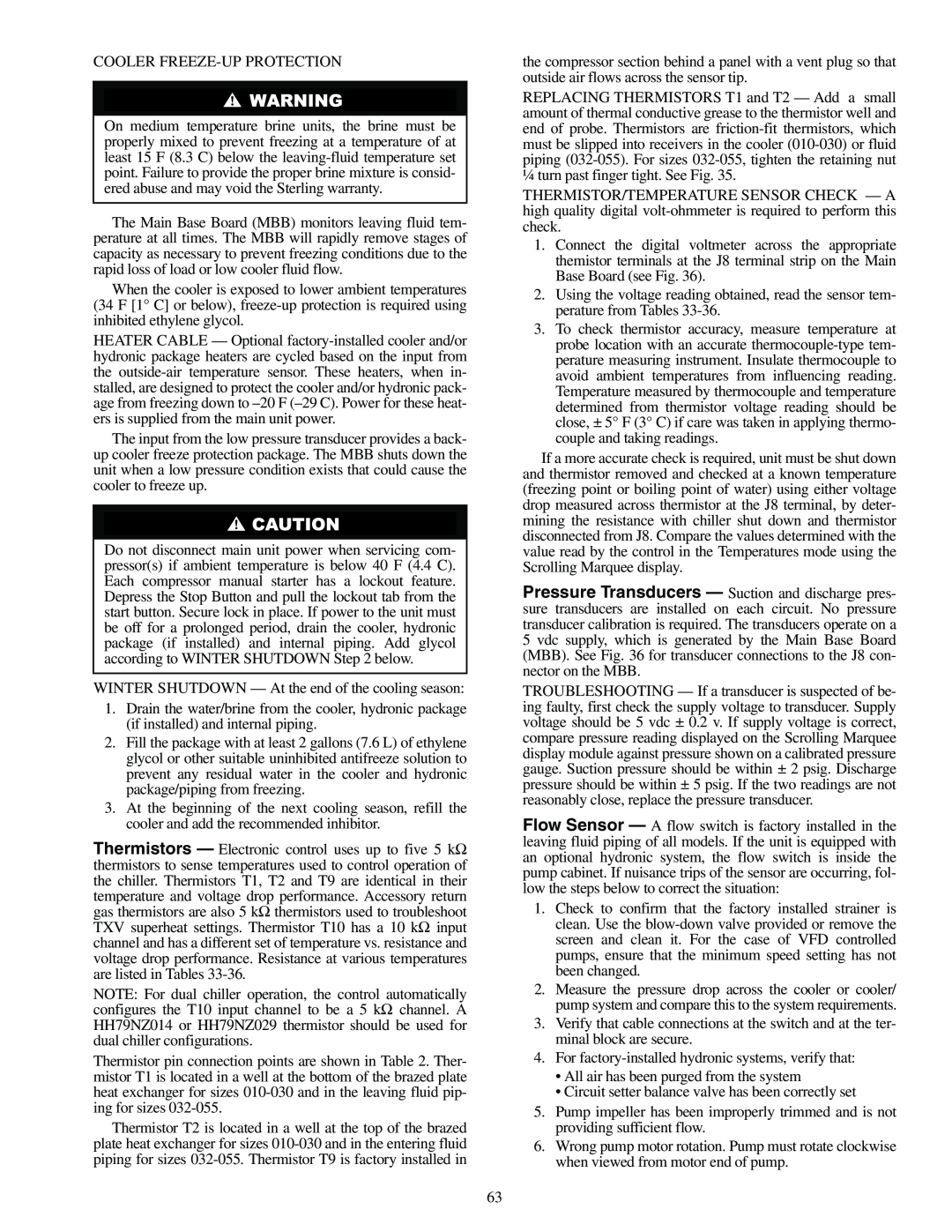
COOLER FREEZE-UP PROTECTION
On medium temperature brine units, the brine must be properly mixed to prevent freezing at a temperature of at least 15 F (8.3 C) below the
The Main Base Board (MBB) monitors leaving fluid tem- perature at all times. The MBB will rapidly remove stages of capacity as necessary to prevent freezing conditions due to the rapid loss of load or low cooler fluid flow.
When the cooler is exposed to lower ambient temperatures (34 F [1° C] or below),
HEATER CABLE — Optional
The input from the low pressure transducer provides a back- up cooler freeze protection package. The MBB shuts down the unit when a low pressure condition exists that could cause the cooler to freeze up.
Do not disconnect main unit power when servicing com- pressor(s) if ambient temperature is below 40 F (4.4 C). Each compressor manual starter has a lockout feature. Depress the Stop Button and pull the lockout tab from the start button. Secure lock in place. If power to the unit must be off for a prolonged period, drain the cooler, hydronic package (if installed) and internal piping. Add glycol according to WINTER SHUTDOWN Step 2 below.
WINTER SHUTDOWN — At the end of the cooling season:
1.Drain the water/brine from the cooler, hydronic package (if installed) and internal piping.
2.Fill the package with at least 2 gallons (7.6 L) of ethylene glycol or other suitable uninhibited antifreeze solution to prevent any residual water in the cooler and hydronic package/piping from freezing.
3.At the beginning of the next cooling season, refill the cooler and add the recommended inhibitor.
Thermistors — Electronic control uses up to five 5 kΩ thermistors to sense temperatures used to control operation of the chiller. Thermistors T1, T2 and T9 are identical in their temperature and voltage drop performance. Accessory return gas thermistors are also 5 kΩ thermistors used to troubleshoot TXV superheat settings. Thermistor T10 has a 10 kΩ input channel and has a different set of temperature vs. resistance and voltage drop performance. Resistance at various temperatures are listed in Tables
NOTE: For dual chiller operation, the control automatically configures the T10 input channel to be a 5 kΩ channel. A HH79NZ014 or HH79NZ029 thermistor should be used for dual chiller configurations.
Thermistor pin connection points are shown in Table 2. Ther- mistor T1 is located in a well at the bottom of the brazed plate heat exchanger for sizes
Thermistor T2 is located in a well at the top of the brazed plate heat exchanger for sizes
the compressor section behind a panel with a vent plug so that outside air flows across the sensor tip.
REPLACING THERMISTORS T1 and T2 — Add a small amount of thermal conductive grease to the thermistor well and end of probe. Thermistors are
THERMISTOR/TEMPERATURE SENSOR CHECK — A high quality digital
1.Connect the digital voltmeter across the appropriate themistor terminals at the J8 terminal strip on the Main Base Board (see Fig. 36).
2.Using the voltage reading obtained, read the sensor tem- perature from Tables
3.To check thermistor accuracy, measure temperature at probe location with an accurate
If a more accurate check is required, unit must be shut down and thermistor removed and checked at a known temperature (freezing point or boiling point of water) using either voltage drop measured across thermistor at the J8 terminal, by deter- mining the resistance with chiller shut down and thermistor disconnected from J8. Compare the values determined with the value read by the control in the Temperatures mode using the Scrolling Marquee display.
Pressure Transducers — Suction and discharge pres- sure transducers are installed on each circuit. No pressure transducer calibration is required. The transducers operate on a 5 vdc supply, which is generated by the Main Base Board (MBB). See Fig. 36 for transducer connections to the J8 con- nector on the MBB.
TROUBLESHOOTING — If a transducer is suspected of be- ing faulty, first check the supply voltage to transducer. Supply voltage should be 5 vdc ± 0.2 v. If supply voltage is correct, compare pressure reading displayed on the Scrolling Marquee display module against pressure shown on a calibrated pressure gauge. Suction pressure should be within ± 2 psig. Discharge pressure should be within ± 5 psig. If the two readings are not reasonably close, replace the pressure transducer.
Flow Sensor — A flow switch is factory installed in the leaving fluid piping of all models. If the unit is equipped with an optional hydronic system, the flow switch is inside the pump cabinet. If nuisance trips of the sensor are occurring, fol- low the steps below to correct the situation:
1.Check to confirm that the factory installed strainer is clean. Use the
2.Measure the pressure drop across the cooler or cooler/ pump system and compare this to the system requirements.
3.Verify that cable connections at the switch and at the ter- minal block are secure.
4.For
•All air has been purged from the system
•Circuit setter balance valve has been correctly set
5.Pump impeller has been improperly trimmed and is not providing sufficient flow.
6.Wrong pump motor rotation. Pump must rotate clockwise when viewed from motor end of pump.
63
